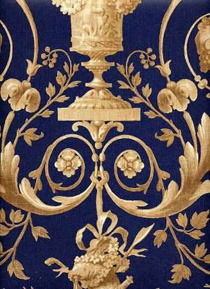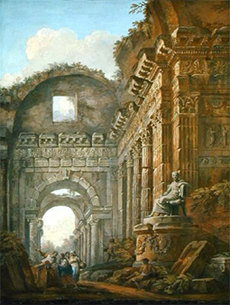 1
1In the mid to late eighteenth century Adam was one of the most sought after architects in England and his Neoclassical designs played a major part in the introduction of the 'Pompeian Style'. He was not without his contemporary critics. John Gwilt in his Encyclopedia of Architecture (1842) praised Stuart’s ‘purity’ and condemned the ‘vicious taste of Robert Adam, a fashionable architect whose eye been ruined by the corruption of the worst period of Roman art.’ Horace Walpole also described Adam’s designs as 'gingerbread and snippets of embroidery’. Hitherto, pastiche versions of ancient wall-paintings had been confined to venues such as the Vatican. In the hands of designers such as Adam, however, they increasingly appeared in palatial houses, before migrating to the homes of the less wealthy in the form of mass-produced wall-paper (fig.1).
Adam in the company of the French neoclassicist painter and architectural illustrator Charles-Louis Clérisseau (1721-1820) visited the Campanian sites in 1755. The designs they subsequently produced had a major impact upon British and European perceptions of ancient wall-painting. Like Adam, Clérisseau’s influence was equally profound, but on the course of Neoclassicism in central Europe (fig.2). In the mid-eighteenth century he spent several decades in Rome as the pupil of the painter Panini who specialised in depicting ruins. Clérisseau also developed this theme and his romanticised visions of ‘classical’ antiquity exerted a profound influence on young visiting architects and artists who used him as a guide and mentor. Clérisseau's ancient Roman ruins became melancholic symbols of a lost Golden Age. As a result Rome became a sign and not a signifier. Divested of autonomous meaning it could only act as a surrogate for the lost world of Classical Greece.
Twenty-three years after Adam, the influential British architect Sir John Soane spent over two years travelling in Italy. The architecture he subsequently produced had a profound impact upon contemporary taste in Britain and its colonies. Many generations of Neoclassical architects acquired their knowledge of antiquity, albeit a decontextualised one, via his collection of ancient fragments, which he displayed in his house in Lincoln’s Inn London (fig.3). In 1835 he published Memoirs of a Professional Architect, in which he further added to the decontextualisation process by Romanticising his moonlight visits to Pompeii. Soane's debt to Pompeii is ironically manifested in Joseph Gandy's visualisation of Soane's design for the Bank of England as a Pompeian ruin (fig.4).
 1
1 2
2
|